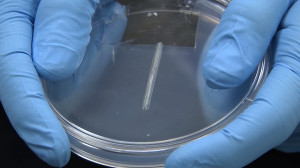In 2004, all we need to do is to purchase is a 3D printer. The printers we commonly use in homes, offices and schools are 2 Dimensional printers. Therefore 3-Dimensional printers are those printers which can print live models and products. Recent reports told us that 3D printers are now capable of printing human body parts too. Let’s see how it’s done.
The first 3D printer was created in 1984 by Chuck hull of 3D systems corp.
If we want to print anything, we need to create a model using computer. Just like a normal printer, we can print out our design easily. 3D printers use materials instead of ink. These materials can be paper, plaster, metal foil, plastic film, modelling clay etc. Organovo is a San diego based company which prints bio organs.
In above image we can see a Liver tissue printed in a petri dish. Printing an organ is a difficult task because the tissue present in our bodies are made up of living cells. Until now, Tissue engineering is at basic level and can’t be considered as commercial product. Printed tissue could improve drug testing and help in solving mysteries of diseases. Just think of the possibilities that this printer will open. No one will have to wait for organ donors any more.
Makerbot is a company that makes 3D printers for commercial use. Makerbot Digitizer scans the 3D objects and Makerbot Replicator prints the designs.
Read similar – 3D printer is back in action
Sources: wikipedia, computerworld, makerbot





2 Comments
So, as well as food is printed from its ingredients or organs-tissue are printed from already living parts, will it be possible to print living cells directly? Perhaps, a tiny virus or a basic cell from simple molecules or atoms? Therefore, step by step, print the whole human being, printing a dream from a artificial-pluripotent stem cell too? Or at least, to print those interrelated genes that by their instructive nature develop complex-working living beings spontaneously? In any case, anything other than a 4D-prosthesis, a tool, an organic robot, a human-like biobot? Or rather, a pampered child of technology? The first child emerging from inert stuff entirely? Something like a modern Frankenstein? Along these lines, there is a peculiar book, a public preview in http://goo.gl/rfVqw6 Just another suggestion for leisure, far away from dogmas or axioms
Ulises_Jofre It looks like a simple task, but it’s not. Teleportation is an application of such a process. Creating living human cells is impossible until now.